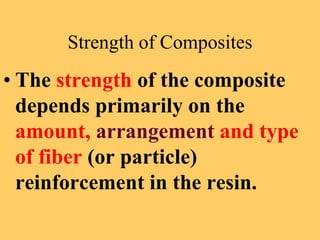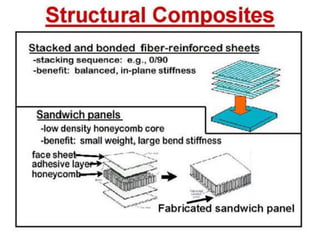Composites.ppt
- 3. Composite Materials Definition of Compsites Composites are engineered materials made from two or more constituent materials with significantly different physical or chemical properties and which remain separate and distinct on a macroscopic level within the finished structure.
- 4. Composite materials are generally used for buildings, bridges, and structures such as boat hulls, swimming pool panels, bathtubs, storage tanks, imitation granite and cultured marble sinks and countertops. The most advanced examples perform routinely on spacecraft and aircraft in demanding environments.
- 5. Increasingly it is becoming evident that the lines of demarcation between traditional disciplines such as metallurgy, ceramics and polymers are getting quite blurry.
- 6. Matrix Rule The matrix material surrounds and supports the reinforcement materials by maintaining their relative positions. The matrix material largely determines the processing method. Reinforcement Rule The reinforcements impart their special mechanical and physical properties to enhance the matrix properties.
- 7. The Final Result • If the composite is designed and fabricated correctly, it combines the strength of the reinforcement with the toughness of the matrix to achieve a combination of desirable properties not available in any single conventional material.
- 8. For example: • polymer/ceramic composites have a higher modulus than the polymer component, • but are not as brittle as ceramics.
- 9. •Typically, reinforcing materials are strong with low densities while the matrix is usually a ductile, or tough, material.
- 10. Considerations for Selecting the Reinforcements & Matrix • There are certain considerations for selecting the reinforcements and the matrix such as: melting point, volatility (instability), density, elastic modulus, coefficient of thermal expansion, strength, creep characteristics, fracture toughness & compatibility between fiber & matrix.
- 11. Combatibility The last consideration of compatibility is divided into three categories, namely: • chemical compatibility, • thermal compatibility & • compatibility with the environment
- 12. Reinforcements Types • Reinforcing phase, is in the form of: • fibers, • Whiskers, • Sheets & • particles • and is embedded in the other materials (the matrix phase).
- 13. Composites According to Type of Reinforcement a: particles, b: whiskers, c: continuous fibers, d: sheet laminate a b C d
- 14. This leads to either addition of properties: GLASS + POLYESTER = GRP (strength) (chemical resistance) (strength and chemical resistance) or unique properties: GLASS + POLYESTER = GRP (brittle) (brittle) (tough!)
- 16. • Fibre: boron; carbon, graphite, SiC, alumina. • Matrix: aluminium; magnesium; titanium; copper • Fibres improve high temperature creep and thermal expansion. Metal Matrix Composites (MMCs)
- 17. Polymer Matrix Composites (PMCs) Thermoplastics Tough; high melt viscosity; and recyclable Thermosets Brittle; low viscosity before cure; not recyclable
- 18. Ceramic Matrix Composites (CMCs) • Fibre: SiC; alumina; Silicon Nitride • Matrix: SiC; alumina; glass-ceramic; Silicon Nitride Fibres improve toughness
- 19. Why are composites used in engineering? • Weight saving (High strength to weight ratio) • High corrosion resistance • High toughness & High T. S. at elevated temp. • Better Fatigue properties • Manufacturing advantages: - novel geometries - low cost tooling • Design freedoms - continuous property spectrum - anisotropic properties • Ease of repair
- 20. Strength of Composites • The strength of the composite depends primarily on the amount, arrangement and type of fiber (or particle) reinforcement in the resin.
- 21. • Typically, the higher the reinforcement content, the greater the strength. • In some cases, glass fibers are combined with other fibers, such as carbon or aramid composite that combines the properties of more than one reinforcing material.
- 22. 1- Particle Reinforcement • Particles used for reinforcing include: • ceramics (SiC) and glasses particles, • metal particles such as aluminum, • polymers and • carbon.
- 23. The Rule of Particles • Particles are used to • Increase the modulus of the matrix, • To decrease the ductility of the matrix. • Particles are also used to produce inexpensive composites.
- 24. Example of Particle Composite • An example of particle reinforced composites is car tire • which has carbon particles in a matrix of the elastomeric polymer poly-iso-butylene.
- 25. Another Example Another example for particle-reinforced composite is concrete where the aggregates ( sand & gravel) are the particles and cement is the matrix. PRCs support higher tensile, compressive and shear stresses.
- 26. 2-Fiber-reinforced Composites: • Reinforcing fibers can be made of metals, ceramics, glasses, or polymers graphite or carbon fibers. Fibers increase the modulus of the matrix material.
- 27. • Practically any material (polymers, metals, glass or ceramics) can be transformed into a fibrous form. • An important attribute of fine fibers is their flexibility. • A high degree of flexibility is really a charectertsitic of a material having a low modulus and a small diameter.
- 28. Glass Fiber • Glasses or amorphous materials show the phenomena of time dependent-strain, called visco-elasticity. Above the glass transition temperature, Tg, such materials show Newtonian viscosity, i.e. the stress is proportional to the strain rate. This property is exploited in the drawing of fiber and sheet forms.
- 29. Advantages of Ceramic Fibers • Continuous ceramic fibers are very good for reinforcing ceramic materials. They combine rather high strength and elastic modulus with high temperature capability and a general freedom from environmental attacks, making them attractive as reinforcements in high temp. ap.
- 30. It is convenient to divide the ceramic reinforcements into: • oxide and • non-oxide categories. The oxides groups contains ceramic oxides such as Al2O3, (Al2O3+SiO2) & ZrO2. While the non-oxide group includes: B, C, SiC, Si3N4 & BN.
- 31. A comparison between the ceramic & composite stress-strain behaviour
- 32. Limitation of using fiber reinforcement • Fibers are difficult to process into composites which makes fiber- reinforced composites relatively expensive.
- 33. Effect of fiber parameters on Composite properties • The arrangement or orientation of the fibers relative to one another, the fiber concentration, and the distribution all have a significant influence on the strength and other properties of fiber-reinforced composites.
- 34. Where to use discontinuous fibers • Applications involving totally multidirectional applied stresses normally use discontinuous fibers, which are randomly oriented in the matrix material.
- 35. • Consideration of orientation and fiber length for a particular composites depends on the level and nature of the applied stress as well as fabrication cost.
- 36. Short fiber advantages • Production rates for short-fiber composites (both aligned and randomly oriented) are rapid, and complicated shapes can be formed which are not possible with continuous fiber reinforcement.
- 37. Fiber orientation in fiber reinforced composites.
- 38. Modulus of Fiber-Reinforced Composites: • Fibers have a very high modulus along their axis, but have a low modulus perpendicular to their axis. If the fibers are all parallel, the modulus of a fiber reinforced composite depends upon which direction you're measuring.
- 39. Modulus of Composite Materials • The modulus of the entire composite, matrix plus reinforcment, is governed by the rule of mixtures when measuring along the length of the fiber by the equation: Ec = EfVf + EmVm
- 40. Where: • Ec is the modulus of the entire composite along the length of the fiber. • Ef is the modulus of the fiber along the length of the fiber. • Vf is the volume percent occupied by the fibers. • Em is the modulus of the matrix (usually not dependent upon direction) • Vm is the volume percent occupied by the matrix (equal to (1-Vf)).
- 41. Tensile strength and elastic modulus when fibers are parallel to the direction of stress.
- 42. tensile strength and elastic modulus when fibers are perpendicular to the direction of stress.
- 43. How to overcome the directional problems • Fiber composite manufacturers often rotate layers of fibers to avoid directional variations in the modulus.
- 44. Structural Composites: • Common structural composite types are: • Laminar • Sandwich Panels
- 45. Laminar: • Is composed of two-dimensional sheets or panels that have a preferred high strength direction such as is found in wood and continuous and aligned fiber-reinforced plastics. The layers are stacked and cemented together such that the orientation of the high-strength direction varies with each successive layer. One example of a relatively complex structure is plywood.
- 46. Sandwich Panels Consist of two strong outer sheets which are called face sheets and may be made of aluminum alloys, fiber reinforced plastics, titanium alloys or steel. Face sheets carry most of the loading and stresses. Core may be a honeycomb structure which has less density than the face sheets and resists perpendicular stresses and provides shear rigidity.
- 48. Why composites aren’t used more in engineering? • High cost of raw materials • Lack of design standards • Few ‘mass production’ processes available • Properties of laminated composites: - low through-thickness strength - low interlaminar shear strength • No ‘off the shelf’ properties - performance depends on quality of manufacture
- 49. There are no ‘off the shelf’ properties with composites. Both the structure and the material are made at the same time. Material quality depends on quality of manufacture.
- 50. Applications of Composite Materials • Examples of some current application of composites include the diesel piston, brake-shoes and pads, tires and the Beechcraft aircraft in which 100% of the structural components are composites.
- 51. • Fiber-reinforced composites are used in some of the most advanced, and therefore most expensive, sports equipment, such as a racing bicycle frame which consists of carbon fibers in a thermoset polymer matrix.
- 52. • Body parts of race cars and some other cars are composites made of fiberglass in a thermoset matrix. Sandwich panels can be used in variety of applications which include roofs, floors, walls of buildings and in aircraft, for wings, fuselage and tail- plane skins.
- 53. Boeing recently completed the first full-scale composite one-piece fuselage section






















































